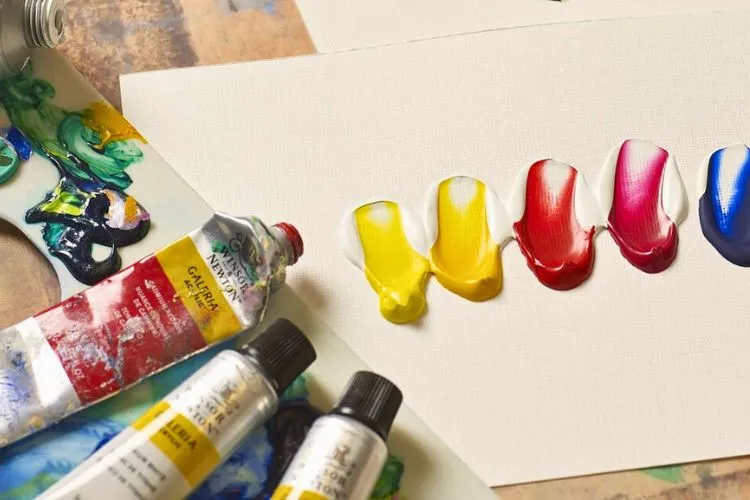Acrylic paints are favored by many artists due to their versatility and vibrant colors. However, one challenge that painters often face is dealing with acrylic paint that has dried out or become unusable.
This guide aims to tackle this issue by providing effective methods on how to revive acrylic paint, helping artists to save money and reduce waste.

Understanding Acrylic Paints
Acrylic paints consist of pigment suspended in a polymer emulsion. They are known for their fast drying properties, which, while advantageous in many painting techniques, can also lead to increased instances of the paint drying out when left exposed.
Understanding the composition of acrylic paints helps in effectively restoring their usability.
Preliminary Steps Before Reviving Acrylic Paints
Before attempting to revive acrylic paints, it is crucial to assess the condition of the paint. Some paints may be past the point of revival, particularly if they’ve completely hardened to the point where they resemble plastic.

To prepare for revival, you will need water, an acrylic medium, containers, and stirring tools. It is also important to work in a well-ventilated area to avoid inhaling fumes from acrylic mediums or solvents.
How To Revive Acrylic Paint?
For Slightly Dry or Thickened Paints
If your acrylic paint has only slightly dried or thickened, adding water or an acrylic medium can help restore its fluidity. Begin by adding a small amount of water to the paint and gently mix it.
It’s important to add water gradually and mix thoroughly to avoid creating air bubbles which can affect the texture of the paint.
Using an acrylic medium instead of water can be beneficial as it enhances the paint’s properties without diluting the color. Mediums like gloss or gel mediums are ideal as they maintain the paint’s body and sheen.
For Severely Dried Paints
For completely dried acrylic paints, the rehydration method involves adding a small amount of warm water to the paint and letting it sit for a few hours.
If necessary, applying gentle heat by placing the container of paint in a warm water bath can facilitate the process.
The solvent method is another technique used for drying paints. Carefully adding a solvent designed for acrylic paint can soften the paint.
However, this method should be used as a last resort due to the potential risks associated with solvent fumes.
For Paint Tubes That Won’t Open
If a paint tube is stuck, try soaking the cap in warm water to loosen any dried paint sealing the cap. Always ensure to close the tube tightly after use to prevent air from drying the paint again.
You may also read: How to Fix Cracked Acrylic Painting?
Storing Acrylic Paints to Prevent Drying
Proper storage of acrylic paints is crucial in preventing them from drying out. Store paints in a cool, dry place away from direct sunlight to preserve their quality.

Innovative storage solutions like vacuum-sealed containers or cling wrap can also be effective in keeping the paints fresh for longer. Moreover, placing a layer of cling wrap directly on the surface of the paint in its container helps prevent skin formation.
Alternative Revival Techniques
Beyond the conventional methods of rehydrating acrylic paints, some artists explore unconventional techniques to breathe life back into their dried paints. A notable approach involves the use of a blend of water with vinegar or fabric softener.
The acidity in vinegar can help break down the dried paint, making it easier to mix back into a workable form.
Similarly, fabric softener can act as a minor solvent, introducing moisture and flexibility back into the paint without significantly altering its original properties.
When using these methods, the key is to start with small amounts, gradually adjusting the mixture until the desired consistency is achieved. These innovative techniques offer artists cost-effective and creative ways to restore their acrylic paints while preserving their quality and vibrancy.
Common Mistakes to Avoid
When attempting to revive acrylic paints, artists should be wary of common pitfalls. A primary error is using too much water, which can overly dilute the paint’s binder, leading to diminished color strength and adhesion.

Overheating the paint is another mistake that can irreversibly alter the paint’s chemical structure, resulting in faded colors and compromised quality. Additionally, impatience can prompt hasty mixing, creating air bubbles or uneven texture.
To avoid these mistakes, artists must proceed with moderation and care, gradually adding water or heat, and mixing gently to ensure the paint’s restoration without sacrificing its integrity.
Pro Tips
Creating DIY mixes with glycerin or honey can help revive acrylic paints while improving their texture. Always test the consistency and quality of revived paints on a scrap material before applying them to your final artwork.
Taking preventative measures such as cleaning the edges of paint tubes and storing them properly can greatly extend the life of the paints.
Frequently Asked Questions (FAQs)
Can you revive acrylic paint with just water?
Yes, for slightly thickened paints, adding a bit of water can help restore them. However, for completely dried paints, other methods like using acrylic mediums may be necessary.
How do you know when acrylic paint is beyond saving?
If the paint has turned into a hard, plastic-like substance, it may be beyond revival.
Is it safe to use revived acrylic paints on all surfaces?
Yes, once properly revived, these paints can be used on any surface that is typically compatible with acrylic paint.
Can adding too much water or medium affect the color or texture of the paint?
Excessive water or medium can indeed dilute the color and alter the texture. It’s important to add small amounts and test the paint as you go.
How can you prevent paints from drying out in the first place?
Properly sealing paint tubes and storing them in cool, dry places can significantly help in preventing them from drying out.
Conclusion:
Understanding how to revive acrylic paints is essential for any artist looking to extend the lifespan of their materials. By following these methods, artists can ensure that they utilize every drop of paint, promoting sustainability and efficiency in their art practices.
With preventive care, the longevity of acrylic paints can be significantly enhanced, supporting both the environment and the artist’s wallet.

Meet Isabella Anderson, your acrylic painting mentor with over a decade of brush-wielding mastery. Dive into the colorful world of acrylics with her expert guidance, featured exclusively on ‘Acrylic Authority.’ Unleash your inner artist and explore the limitless possibilities of this versatile medium alongside a true acrylic aficionado.
